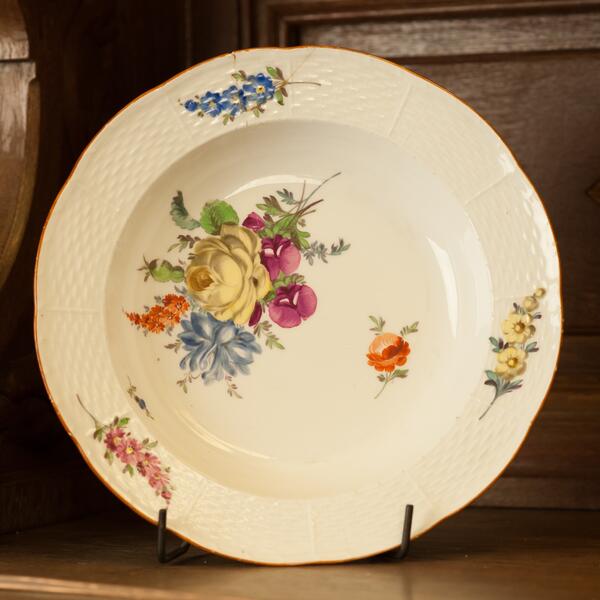The porcelain soup plate with a polychrome painted ornament was made by Meissen Porcelain Manufactory in Saxony, Germany.
The bottom of the plate and its embossed lip are decorated with a polychrome underglaze painting of strewn flowers. Underglaze painting is a notoriously difficult technique as the pigment can change its color drastically after firing. Besides, there is no tolerable margin for painting error, since the line drawn on raw mould can’t be corrected properly. Underglaze paint is applied directly onto the biscuit porcelain, after which the item is submerged in a glaze bath and then undergoes glost firing, which creates a glass-like coating fused with porcelain.
The middle of the 18th century saw the arrival of a new decoration, an “ivy weave” net done in low relief, which can be seen embossed on the lip of the present plate. The net relief was introduced by a talented sculptor and modeler Johann Joachim Kändler in the 1740s and has been in use since.
Meissen Porcelain Manufacture was founded in 1710. Before that, the Europeans had not possessed the secret of true porcelain.
Porcelain first appeared in China as a result of centuries of evolving of the ceramics craft. The secret of its production was coveted for ages by Italy, France and England. However, for over 200 years, all the attempts to recreate porcelain had met with failure with resulting items resembling glass rather than porcelain.
It was in the early 1700s that fine hard-paste porcelain was finally produced in Europe. The formula was successfully discovered by a German mathematician Ehrenfried Walther von Tschirnhaus (b. 1651 – d. 1708) and an alchemist Johann Friedrich Böttger (b. 1682 – d. 1719).
The key to success was the precise blending of kaolin (clay mineral) with native feldspar and quartz, which made the European porcelain similar, if not identical to the Chinese original. By 1713, Meissen manufacture had started producing white hard-paste porcelain on a massive scale.
Meissen manufacture has played a key role in European porcelain industry. As it was the first manufacture to produce true porcelain in Europe, it got to define the decoration styles for centuries to come.
The bottom of the plate and its embossed lip are decorated with a polychrome underglaze painting of strewn flowers. Underglaze painting is a notoriously difficult technique as the pigment can change its color drastically after firing. Besides, there is no tolerable margin for painting error, since the line drawn on raw mould can’t be corrected properly. Underglaze paint is applied directly onto the biscuit porcelain, after which the item is submerged in a glaze bath and then undergoes glost firing, which creates a glass-like coating fused with porcelain.
The middle of the 18th century saw the arrival of a new decoration, an “ivy weave” net done in low relief, which can be seen embossed on the lip of the present plate. The net relief was introduced by a talented sculptor and modeler Johann Joachim Kändler in the 1740s and has been in use since.
Meissen Porcelain Manufacture was founded in 1710. Before that, the Europeans had not possessed the secret of true porcelain.
Porcelain first appeared in China as a result of centuries of evolving of the ceramics craft. The secret of its production was coveted for ages by Italy, France and England. However, for over 200 years, all the attempts to recreate porcelain had met with failure with resulting items resembling glass rather than porcelain.
It was in the early 1700s that fine hard-paste porcelain was finally produced in Europe. The formula was successfully discovered by a German mathematician Ehrenfried Walther von Tschirnhaus (b. 1651 – d. 1708) and an alchemist Johann Friedrich Böttger (b. 1682 – d. 1719).
The key to success was the precise blending of kaolin (clay mineral) with native feldspar and quartz, which made the European porcelain similar, if not identical to the Chinese original. By 1713, Meissen manufacture had started producing white hard-paste porcelain on a massive scale.
Meissen manufacture has played a key role in European porcelain industry. As it was the first manufacture to produce true porcelain in Europe, it got to define the decoration styles for centuries to come.


